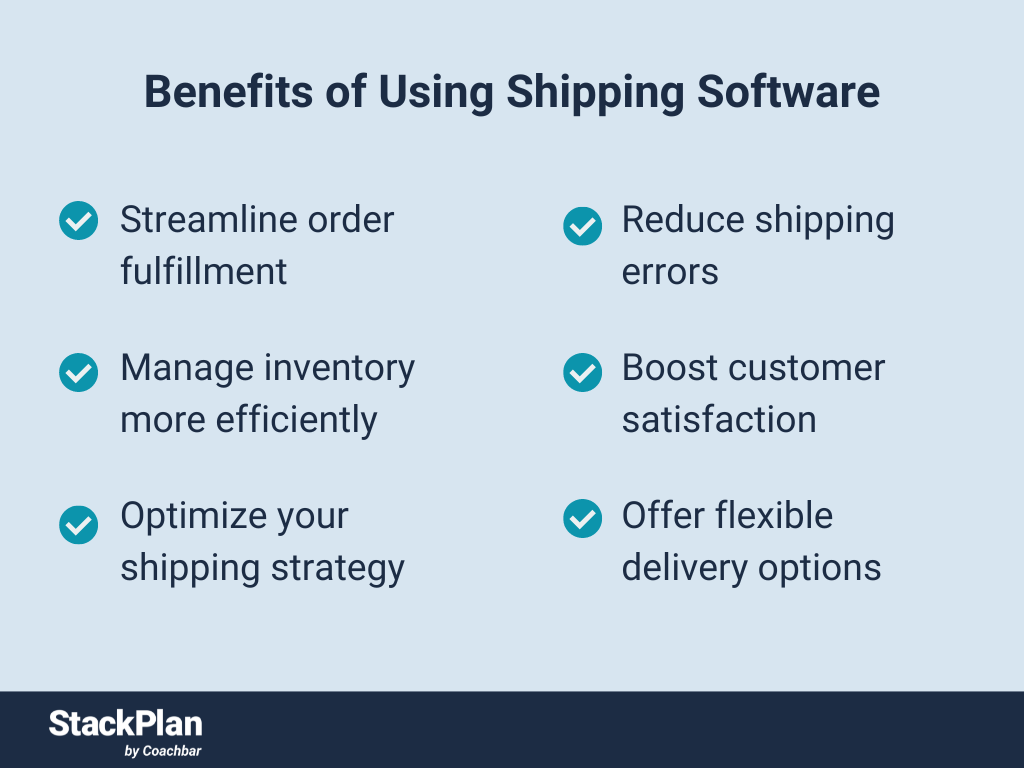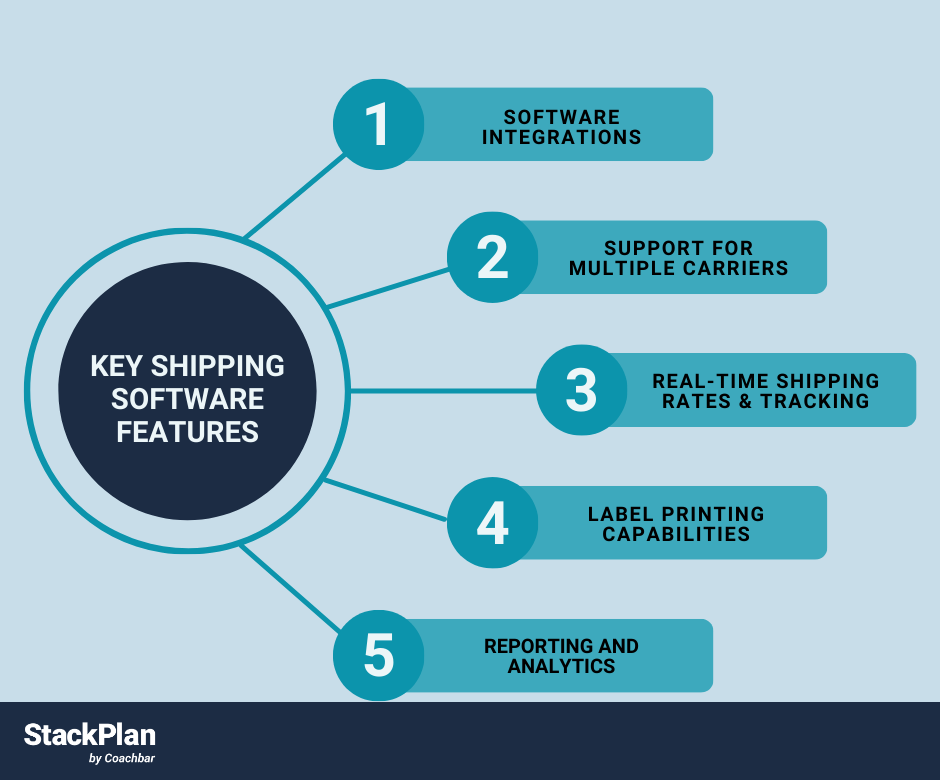Around 86% of customers want options when it comes to delivery, and over 13% of customers won’t reorder from a company if a delivery is late.
The benefits of using shipping software
Shipping software is an essential tool for any retail or wholesale business. With it, you can optimize your order fulfillment process, reduce shipping errors and enhance customer satisfaction.
Streamline order fulfillment
Manage inventory more efficiently
Optimize your shipping strategy
Reduce shipping errors
Boost customer satisfaction
Timely and accurate delivery is critical to maintaining happy customers. With shipping software, you can provide real-time tracking updates, generate branded packing slips and ensure on-time delivery. These features can help improve the customer experience and strengthen your brand reputation.
Offer flexible delivery options
Finally, shipping software can help you offer more flexible delivery options to your customers. Some software can even integrate with carrier services that offer same-day or next-day delivery. This can help you meet the needs of customers who require fast shipping while also providing a competitive advantage over businesses that don’t offer these options.

How to choose the right shipping software
No two businesses are the same, and what you need from shipping software might be very different to similar businesses in your area. Here’s how to choose shipping software that works for your business process.
1. Evaluate your shipping volume
If your business is growing, you need shipping software that can handle the increased volume of orders, and orders from multiple systems. On the other hand, if you’re a small business, you may not need sophisticated shipping software that can handle large volumes of orders.
It’s also important to consider the nature of your products. If you sell bulky or heavy items, you’ll need shipping software that can handle the weight and size of your products.
2. Identify required shipping services and carriers
Shipping services vary depending on the carrier and the type of products you sell. Some carriers offer standard shipping, while others offer expedited or overnight shipping. Identify the shipping services required by your business and choose a software provider that supports them.
You also need to consider the carriers you use. Some shipping software only supports specific carriers, while others support multiple carriers. Make sure the software you choose supports the carriers you use or plan to use in the future.
3. Consider your budget
Cost is always a significant factor when choosing software for your business. The cost of shipping software varies depending on the features available. Look for software that aligns with your budget while still offering the features your business needs to succeed.
It’s important to note that the cheapest option may not always be the best. You need to consider the long-term benefits of investing in more expensive shipping software that can meet your business’s unique needs in the future.
4. Evaluate how the shipping software integrates with your other software applications
Shipping software is only one of several applications your business will use. Investigate how orders flow from your online ecommerce stores and marketplaces into your accounting, ERP/inventory, and shipping application. Watch out for shipping applications that say you can integrate too easily or ones that avoid talking about integrations.
You should ask and get answers to how product returns and change of address requests are managed. These scenarios surface the important questions of which application is the source of truth for customer addresses and which application you will need to learn and use everyday. If something doesn’t seem right, it probably isn’t and you shouldn’t settle for an app that does an okay job when there are apps that do shipping really well. Be sure to ask your software consultant to recommend and comment on each of the shipping applications in light of the other software your business uses or plans to use in the future.

Key features to look for in shipping software
No matter what provider you decide to go with, there are a few key features your new shipping software should have.
Integration with ERP, inventory and order management, ecommerce and shopping platforms
One of the most important features to look for in shipping software is integration with your ecommerce platform and your core business software systems like your ERP or inventory/order management software. This integration allows the software to update your orders and inventory in real-time and seamlessly transfer data between your store and the software. This feature will save you time and reduce errors, ensuring that your customers receive their orders promptly.
Some popular ecommerce platforms that shipping software can integrate with include Shopify, WooCommerce, Magento, and BigCommerce, but check if your platform is included in the integrations list.
If you sell on multiple platforms, like Amazon or Etsy, you’ll also want to consider if the shipping system can accept orders from those platforms, your inventory management system, or ERP.
Support for multiple carriers
This feature allows you to choose the best shipping carrier for each order based on factors such as cost, delivery time, and destination. Having access to multiple carriers can also help you negotiate better shipping rates and reduce your shipping costs.
When selecting shipping software, ensure that it supports multiple carriers, including the most popular ones: USPS, FedEx, UPS, and DHL.

Real-time shipping rates and tracking
Accurate real-time shipping rates and tracking information are critical components of any shipping software. This feature ensures that you don’t pay too much for shipping and can provide customers with up-to-date tracking data.
Label printing capabilities
Printing shipping labels can be a time-consuming and error-prone process. So, your shipping software should be able print shipping labels easily. This feature can save you time and improve accuracy, ensuring that your packages are labeled correctly – even for different platform labeling requirements – and delivered to the right address.
Reporting and analytics
Reporting and analytics can help you measure the performance of your shipping operations. Look for shipping software that provides you with insights into your shipping costs, volume, and other key metrics. This feature can help you identify areas for improvement, optimize your shipping processes, and make data-driven decisions to improve your shipping operations over time
The best shipping software for retail and ecommerce businesses
Now we know the key features to look for, let’s compare some of the best shipping software providers on the market.
Which shipping software is right for you?
Figuring out how to choose shipping software for your business can be daunting. By evaluating your business’s unique shipping needs, comparing features, and considering your budget, you can choose a shipping software that makes the shipping process stress-free
If you want help choosing the right shipping software for your business, we can help. Our software consultants will get to know your business, figure out which shipping solution is right for you, and help implement it seamlessly into your business operations. Get in touch with our team today, and we’ll help you improve your shipping process.
Need help choosing the
right shipping software for your business?
Find a software consultant that specializes in your industry by checking out our directory.








